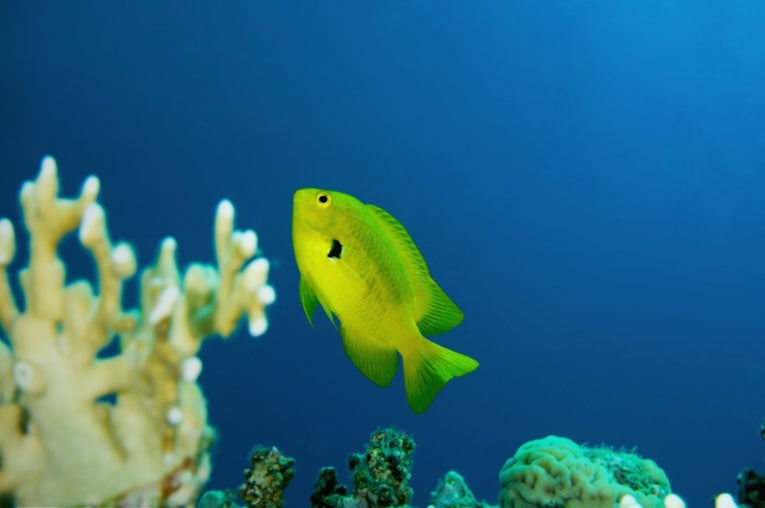Biologically, beautifully-stacked, ecologically threatened and culturally, one of our icons of the 21st century, the coral reef! Along with some producers such as grasses, kelps and mosses, habitat formation is their forte. Many such oceanic and terrestrial habitats are threatened by human activity and natural mechanisms.
The consequent reduction in diversity is likely to affect us all, so a paper published in the Proceedings of the Royal Society B: Biological Sciences this week on fish competition within the reef is a welcome and necessary addition to our knowledge of how we conserve.
The damselfish is a planktonic larval coloniser able to settle on live hard corals. The two species studied are Pomacentrus amboinensis, from Ambon, a generalist, and P. moluccensis a more delicate lemon damselfish, presumably resident in the Moluccas. The Barrier Reef, at York Island, however, was the site of the research. What Mark McCormick of James Cook University in Queensland did was to collect the larvae with light traps and feed them on brine shrimp. Then the bushy hard coral, in three states, was provided for their settlement:
The larvae differed in mortality. While P. ambon, the generalist, didn't change in its survival rate, P.mol was affected by the habitat and the presence of P.ambon. It particularly failed on bleached and dead coral when its competitor was present. The graphs in the paper illustrate this very well. Below is an example of how drastically affected the poor old P.mol is, even on healthy coral:

Credit: © Proceedings of the Royal Society B: Biological Sciences
Above: Mortality trajectories of Pomacentrus amboinensis: (P. ambo) and P. moluccensis (P. mol) released as solitary individuals of as pairs onto patches of healthy live coral. The black P. mol graph shows its low survival rate, even on healthy coral, when its P.ambo competitor is present.
Aggression had a lot to do with the death of the P.mol. Even P.ambon suffered with intra-specific competition between dominants and lesser individuals. Mortality among young "settlers" among the coral is usually high because only live coral provides enough cover for tiny fish to escape predation. The interactions with predators changed very significantly with degraded coral. More than later life stages, these fish were lost very easily, so competition caused greater exposure as prey. The resident ambushers were the lizardfish Synodus dermatogenys and small cod Cephalopholis microprion, while pursuit experts like dottybacks, Pseudochromis fuscus, and wrasse, Thalassoma lunare, could easily pick off unwary wanderers.
So the community develops as coral degrades, often at the expense of specialist species and more so with their vulnerable juveniles. The dynamics of two related species out-competing each other at this stage is a crucial discovery here and relevant to such dynamic change everywhere. How these two species compete when older (after two months in the coral, they distribute themselves around the reef more) is under investigation, but basically still unknown. The dominance hierarchy then and at the early stage here is important. In Papua New Guinea, P.mol does well on its own, indicating the pressure of its competitor somehow forces this species to expose itself as a free lunch. What is also interesting is that individual fish keep close to cover on healthy coral, while bleached coral makes them more likely to expose themselves. Camouflage might be involved, or the lack of it, and it's likely that the smell of dead coral could affect behaviour. Once a P.ambon aligns itself near another, then intra-specific competition rears its ugly head, the outcome often being the movement of the non-dominant into dangerous situations.
In all such colonisation procedures or even hatchings, nature takes its toll on the uninitiated, naive and numerous. Predators the world over gather for such occasions and the reef is no different. Mark quotes, "the trajectory that a community on a changing habitat patch will follow is contingent on understanding the links between species and how these alter as habitat characteristics change."
We need to start observing how vulnerable species become as their habitat alters. We need to stop guessing at links and study the earth carefully. The American wolf roams free, but needs its elk. The British house sparrow is breeding on our roofs once more, while butterflies flutter tantalisingly close to extinction. Whale species, some say, have recovered, but their habitat certainly has not. Just where and how do we fit in. Are we saviours, simple sinners or just the last predator of that last fish on the reef?
href="https://earthtimes.org/environment/coral/index.html">Coral / Pollution /









